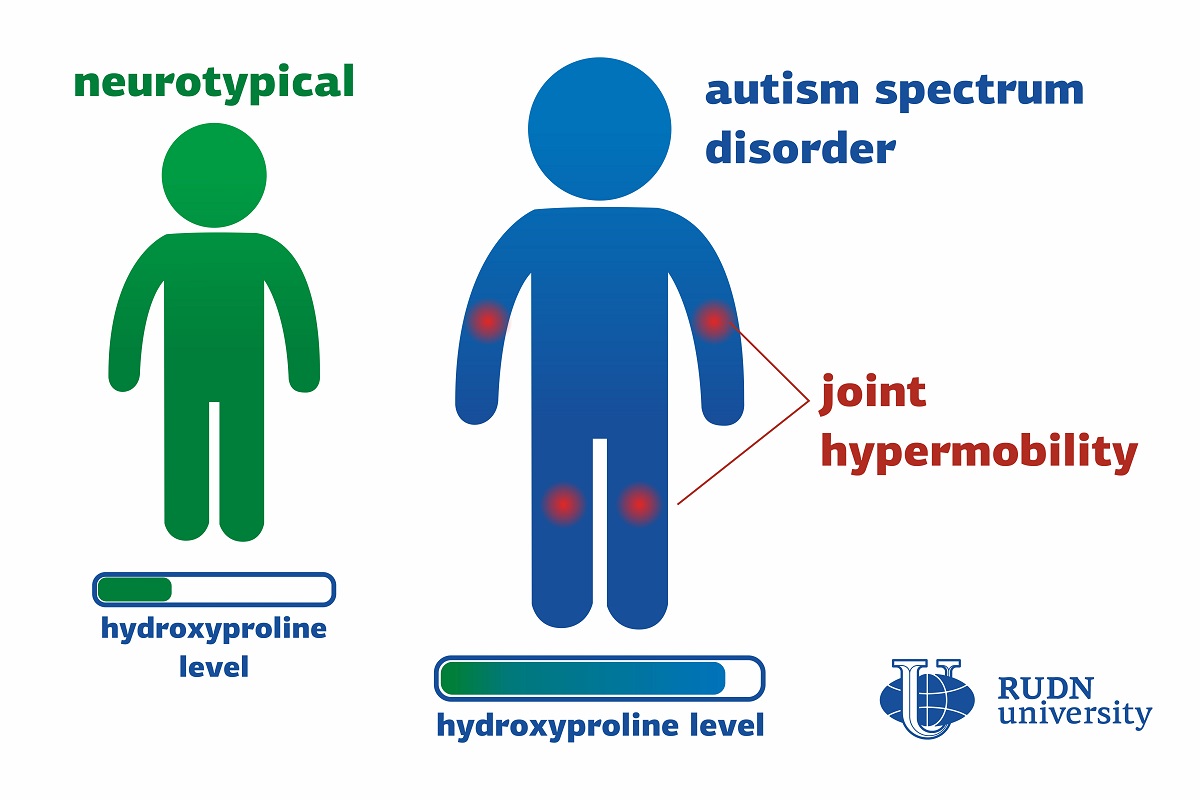Scientists found a connection between amino acid metabolism and joint hypermobility in autistic children

Amino acids are the building blocks of proteins, and proteins are what our muscles, internal organs, and also enzymes and hormones are made of. They control our daily functioning and secure healthy growth and development of our bodies. Both lack and excess of amino acids can cause health issues. One of the factors that can have a negative impact on the balance of amino acids is autistic spectrum disorder or ASD. It manifests itself in a patient's early childhood and remains with them for the rest of their life. It is still unknown how exactly ASD affects a patient's amino acid profile and what effects it has on their body. However, a team of researchers found out that children with ASD have increased levels of the amino acid hydroxyproline. This may be associated with joint hypermobility, a common symptom in ASD patients.
"The available data about the amino acid profile of ASD patients is quite contradictory which may be due to age and gender differences, specifics of clinical treatment, and other parameters. Information about the levels of several amino acids at a given time can help better understand the specifics of metabolism in ASD patients. That is why in our work we focused on studying the levels of amino acids in children's blood serum," said Alexey Tinkov, a Candidate of Medical Sciences, and a lecturer at the Department of Elementology at RUDN University and Yaroslavl State University.
The participants of the study were 97 boys from 3 to 14 years of age, of which 64 were diagnosed with ASD. The levels of amino acids in their blood serum were measured using high-efficiency liquid chromatography with UV detection. This method allowed the researchers to break the samples down to their components and measure their concentrations.
Four amino acids (leucine, serine, tyrosine, and hydroxyproline) turned out to be associated with ASD. Hydroxyproline is a component of collagen, the basis of all connective tissues: tendons, bones, and cartilages. Therefore, the team assumed that increased hydroxyproline levels might be the cause of joint hypermobility. By various estimates, this disorder is found in 15% to 50% of young ASD patients. The level of hydroxyproline in the blood of healthy children amounted to 0.87 mg per liter, while in ASD patients it reached 1.7 mg/l. The team also found out that the levels of arginine, glutamine, histidine, leucine, lysine, phenylalanine, serine, taurine, tryptophan, and threonine in the blood of children with ASD were 15% to 28% lower than in healthy ones. Among other things, these amino acids regulate the growth and reconstruction of body tissues. According to the researchers, their deficiency can negatively affect a child's psychomotor development.
"We assumed that increased hydroxyproline levels might be associated with joint hypermobility, and the deficiency of other amino acids might affect the neuronal dysfunction. Further studies may identify potential targets for proactive treatment. Theoretically, the normalization of amino acid balance can become an additional tool for ASD therapy," added Prof. Anatoly Skalny, MD, the head of the Department of Medical Elementology at RUDN University.
The work was published in the Research in Autism Spectrum Disorders journal.
RUDN summarized the results of the scientific competition "Project Start: work of the science club ". Students of the Faculty of Physics, Mathematics and Natural Sciences have created a project for a managed queuing system using a neural network to redistribute resources between 5G segments. How to increase flexibility, make the network fast and inexpensive and reach more users — tell Gebrial Ibram Esam Zekri ("Fundamental Computer Science and Information Technology", Master's degree, II course) and Ksenia Leontieva ("Applied Mathematics and Computer Science", Master's degree, I course).
The National Demographic Report, 2023 Demographic Well-Being of Russian Regions (hereinafter - the National Demographic Report) was prepared by the scientific team of the Institute of Demographic Studies of the Federal Research Center of the Russian Academy of Sciences, the Vologda Scientific Center of the Russian Academy of Sciences, Peoples' Friendship University of Russia, the Center for Family and Demography of the Academy of Sciences of the Republic of Tatarstan, as well as with the participation of leading scientists from the Republic of Bashkortostan, Stavropol Krai, Volgograd, Ivanovo, Kaliningrad, Nizhny Novgorod, Sverdlovsk Oblasts and Khanty-Mansi Autonomous Okrug–Yugra.
RUDN summarized the results of the scientific competition "Project Start: work of the science club ". Students of the Faculty of Physics, Mathematics and Natural Sciences have created a project for a managed queuing system using a neural network to redistribute resources between 5G segments. How to increase flexibility, make the network fast and inexpensive and reach more users — tell Gebrial Ibram Esam Zekri ("Fundamental Computer Science and Information Technology", Master's degree, II course) and Ksenia Leontieva ("Applied Mathematics and Computer Science", Master's degree, I course).
What is your first association with the word “laboratory”? Flasks and beakers? Microscopes and centrifuges? Yes, many of us would answer the same way.
The National Demographic Report, 2023 Demographic Well-Being of Russian Regions (hereinafter - the National Demographic Report) was prepared by the scientific team of the Institute of Demographic Studies of the Federal Research Center of the Russian Academy of Sciences, the Vologda Scientific Center of the Russian Academy of Sciences, Peoples' Friendship University of Russia, the Center for Family and Demography of the Academy of Sciences of the Republic of Tatarstan, as well as with the participation of leading scientists from the Republic of Bashkortostan, Stavropol Krai, Volgograd, Ivanovo, Kaliningrad, Nizhny Novgorod, Sverdlovsk Oblasts and Khanty-Mansi Autonomous Okrug–Yugra.